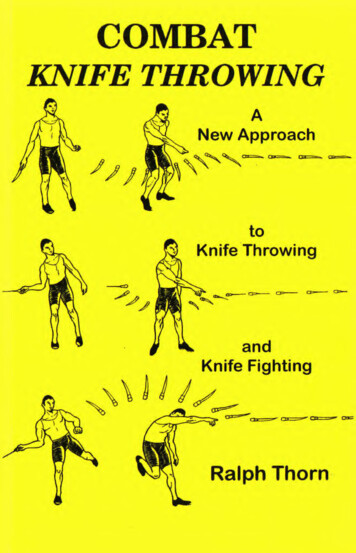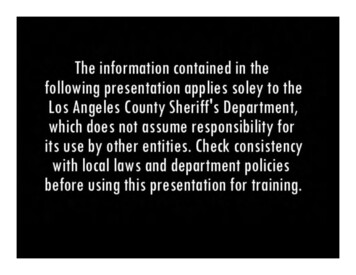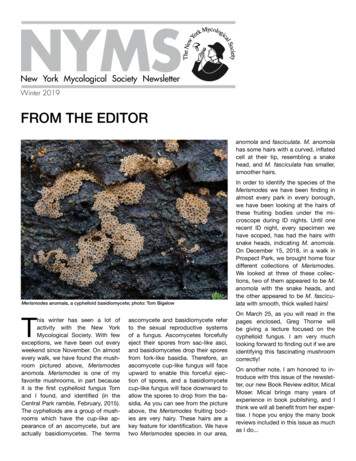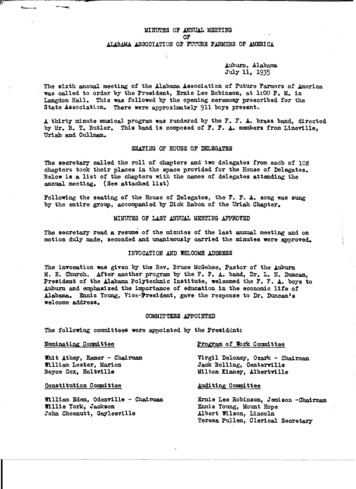
Transcription
'I
Ralph Thorn
rCOMBATKNIFE THROWINGA New Approach to Knife Throwingand Knife Fightingby Ralph ThornLoompanics UnlimitedPort Townsend, Washington
Neither the author nor the publisher assumes anyresponsibility for the use or misuse of information contained inthis book. It is sold for entertainment purposes only. Be warned!ContentsIntroducing Spear-Style and Combat Knife Throwing.1Chapter OneBalancing a Knife for Throwing.13Combat Knife ThrowingA New Approach to Knife Throwing and Knife FightinqChapter TwoTargets and Safety.35 2002 by Ralph ThornChapter ThreeSpear-Style Knife Throwing.49All rights reserved. No part of this book may be reproduced or storedin any form whatsoever without the prior written consent of thepublisher. Reviews may quote brief passages without the writtenconsent of the publisher as long as proper credit is given.Published by:Loompanics UnlimitedPO Box 1197Port Townsend, WA 98368Loompanics Unlimited is a division of Loompanics Enterprises IncPhone: 360-385-2230Fax: 360-385-7785E-mail: service@loompanics.comWeb site: www.loompanics.comCover and illustrations by Ralph ThomISBN 1-55950-227-4Library of Congress Card Catalog Number 2002103993Chapter FourCombat Knife Throwing.73Chapter FivePsychological and Physical Conditioning.97Chapter SixHunting and Recreational Skills.105
Introducing Spear-Style and Combat Knife Throwing1Introducing Spear-StyleandCombat Knife ThrowingFigure 1A throwing knife whose weight is in its front end will turn circlesin the air. making it difficult to stick into a target.Conventional wisdom among knife-Fighting experts has itthat knife throwing is a pursuit best left to circus performers,hillbilly theme parks, and hobbyists and that it is useless forcombat or other survival purposes. You see, the only realisticway to seriously hurt someone or something with a thrownknife is to get a “penetration” (stab, as opposed to slash)wound, and the only way to get said stab wound is to, unsur-
rIntroducing Spear-Style and Combat Knife ThrowingCombat Knife ThrowingA New Approach to Knife Throwing and Knife Fighting32prisingly enough, hit the target/victim with the knife point-first(called a “stick” in knife-throwing parlance). And you see,child, it is difficult, almost impossible, to stick a knife into unpredictably moving targets. As every one of the handful ofknife-throwing manuals, hunting magazine articles, or Internetfan sites in existence seem to state explicitly (when they don’tassume you already know), since a knife inevitably turns han dle-over-blade circles in its natural flight path (a phenomenonvariously called “spin,” “rotation,” or “revolution”), the onlyway to throw one and stick it into a target more than a step ortwo away is to perfonn the following process: Carefullymeasure the distance it takes for a particular knife, thrown bya particular person, to make a particular number of revolutionsone-half one, two, etc. — and then have that exact personalways throw that exact knife, from that exact distance, at thatexact speed, to achieve that exact number of rotations, andthus a stick. If you throw by the handle and the knife revolvesaround precisely once as it travels to the target, presto — ithits point-first on impact. If you throw by the blade and it re volves exactly one and one-half times — you again get a stick.The trick, then, is just to always stand the same distanceaway for each of these throws and to throw them so that theknife always revolves at the same rate of speed. You thushave, say, a one-half-spin throw you use at 4' 6", a full-spinthrow that you throw from 9 feet, a spin-and-a-half at 12 feet,and so on, with various tricks and variations thrown in (no punintended) for variety. Unless you are able to vary this rate ofspeed at which the blade rotates, which leads to far lydiscouraged, the areas in between these set distances arc ig nored. (It should be noted that the rate of speed of this rotationis not the same as the speed at which the knife travels to thetarget, just how fast it is flipping over itself as it does so,though both must remain constant in this method of throwing.)Professionals, while they throw very accurately at still targets,always throw from a same few measured distances. Throwingfrom in between them would cramp their style and result in theknife bouncing off the target; it is therefore considered point less (pun intended).Only at a distance of a pace or so, they say, is it possible tosimply hold a knife by the handlefalsely assumed, I sup pose, by the naive masses of a bread-buttering public to be theonly way to hold a gosh-dam knife — and throw it point-firstand get a stick. Even from mere feet away the knife will spinaround enough to cause it to hit with the flat of the blade orthe butt of the handle. The throwing knives you see advertisedas such, aside from being nearly handleless and guardless, areobviously balanced to have their weight disproportionately inthe front end, just to turn over in the air- rotate- morequickly and predictably.Similarly, the sport is closely linked to hatchet throwing,where the weight of the weapon is distributed likewise (acomparatively light handle with a heavy head). All this obvi ously means that it is impossible to stick any target if any oneof three conditions occurs: a.) you move non-laterally relativeto the target (toward or away from it) a few inches as youthrow; b.) the target does likewise; or c.) both a and b. This iseasy enough to prevent at the circus, but in fighting or huntingsituations these are not entirely unlikely events, and the practi cal uses of knife throwing are thus rightly relegated not to thearts of combat or survival but to the art of performance, wheregirls attach themselves to spinning wooden wheels whilerhinestone cowboys standing a couple of steps away definetheir silhouettes in flashing metal; where celluloid Bowieknives regularly fly end-over-end for forty feet, evidently inblissful ignorance of their ineffectiveness in the real world,and cause instant death to mustachioed serial villains wearingblack hats.
Combat Knife ThrowingA New Approach to Knife Throwing and Knife FightingIntroducing Spear-Style and Combat Knife Throwing45ground, and then end the conflict according to the dictates ofyour conscience, for you are now doubly armed while he isdisarmed and at your mercy.XXXFigure 2Like other types oj performers, circus knife throwers must "hittheir marks "they can only throw from set locations.Figure 3Throwing a knife point-first at a target, like you would a spear, isOnly those ignorant of the basic mechanics of knife titrow ing could believe in such a thing as this latter. They are proba easy if the knife is balanced and gripped properly.bly the same people who think Jean-Claude van Damme andThere is nothing wrong with such conventional wisdom re Steven Seagal are real butt-kicking martial artists. And any garding the usefulness of this style of knife throwing as a selfdefense or survival tool. There is something dramaticallyway, those little throwing knives you see in the catalogs justaren’t big and heavy enough to have “stopping-power” capa wrong with the single assumption underlying this whole the bility. If you did manage to get lucky and hit somebody point-ory of knife throwing (which I hereafter call “circus throw first you’d probably just bounce it off their sternum or forearmand do nothing more than make them mad, in addition to los ing”). This assumption underlies the shape of seemingly everythrowing blade forged since Wild Bill Hickcock toured the ter ing your weapon — although this would at least have the du ritory west of the Mississippi — knives which are then sold,bious benefit of ending the suspense over the fight’s outcome.It is reasonable among experts, such as they are, to assumepresumably, to people who have somehow gotten circus-stylethat anybody who thinks there is such a thing as combat knifethrowing just doesn’t know what he is talking about. If you getcircular, self-perpetuating process. That assumption is, again,only this: that a knife leaving a human hand must tumble un into a knife fight keep your knife in your hand, and if somegraciously end-over-end through the air if it is thrown any dis tance not measured in inches, as Moses declared from thefool tries to throw his at you, simply put an arm block in frontof your face, take one step forward or back, watch the butt-endof his blade bounce harmlessly off your arm and hit thethrowing instructions and learn to throw them in this way, in amountaintop and Sir Isaac Newton decreed into law, and that'
rCombat Knife ThrowingA New Approach to Knife Throwing and Knife Fighting6knife-flinging mankind — and womankind — must learn toaccept this simple commonsensc limitation.In fact, it is perfectly possible (and very easy) to change thebalance of a knife or sword of nearly any reasonable size(roughly, from hunting-knife size up to 30 inches) so that itwill fly point-first at a target several yards away without thepoint ever dropping more than slightly, let alone rotating circularly; that is, so that it will fly the way a spear or arrowflies. It is therefore perfectly possible to hit a target point-firstwith a knife from any range that your arm strength will allow,with a multiplicity of arm angles (overhand, underhand, sidearm, even around-the-back) whether it, or you, or both aremoving in any direction as you do so. These targets can be hithard enough to do them very serious damage, including instantfatal damage if you hit the right spots on a living target.It is furthermore perfectly possible (though not quite aseasy) to balance and throw that same knife in such a way as tobe able to control the rate of speed at which it rotates in the airwithout seriously compromising the velocity with which it ap proaches the target. Thus, by varying that rate of speed, youcan hit any target point-first from any distance equal to or lessIntroducing Spear-Style and Combat Knife Throwing7because practiced knife throwers of the circus style simply donot believe it, and people unfamiliar with knife throwing donot even realize that circus-style throwers cannot in fact sim ply throw knives from variable distances the way one wouldany other object. (I will not further insult your intelligence bystating the desirability of being able to throw a knife in muchthe same way you would throw a ball or, more ominously,shoot a bullet.) None of this takes any special equipment ortalent — only some practice, a roll or two of tape, and a knifewith its weight more in the handle end than the blade end.This method, to say the least, changes the equation of theutility of knife throwing in life-or-dcath situations. It also hasthe benefit of making it a heck of a lot more fun to do, whichwill lead to gelling that necessary practice more painlessly (if,perhaps, not less injuriously!).1 know these things are possible because 1 do them all thetime, and have for years. My inspiration for putting my quiverfull of knife-slinging techniques into writing is twofold: One, Iwant to make people aware of the nonsensical, self-imposedlimitations of circus throwing, a style which even the majorityof its adherents admit is useful only for entertainment pur than the maximum range your ability gives you — again, notposes. Most of the advice given out by these types of throwersis, from the point of view of my experience, nearly totally use just the artificial set distances that circus throwers almost al ways stand at and throw from due to the inherent limitations ofless to the layman at best, or dangerously ignorant and wrongtheir style, but also that far vaster territory in between thoseset points.at worst. (A glaring example of this would be the lunaticassertion in one pamphlet that the best combat throw is theIt is not at all impossible, by using either of these two meth backhand. It is categorically, inarguably, undeniably the worst,for at least four reasons I know of and will make clear in theods, to throw knives from real-time, real-life variable dis tances and angles, the same simple way you would throw achapter on combat. Here’s a quick preview: It is slow develop baseball (and every bit as accurately - - in my case much moreaccurately — and most importantly, as accurately as circus-tion both before and afterwards, and is woefully inaccurate instyle throwing and with a greater chance of hitting the targetpoint-first with far less practice). Forgive the repetition of thisvery simple concept, but it seems necessary to emphasize thising, low velocity, leaves the thrower in poor defensive posi that it leaves one unable to significantly adjust the throwingangle to a moving target.) Two, I have a passion for knifethrowing that I want others to share, and I am convinced that if
Combat Knife ThrowingA New Approach to Knife Throwing and Knife FightingIntroducing Spear-Style and Combat Knife Throwing89people who become exposed to knife throwing were not lim It all came about much by accident. I loved playing withited from the start by this inferior style that dominates the ac tivity, more of them might find it appealing enough to try. Af knives almost from the cradle and had often tried throwing or dinary folding and hunting knives even as a preadolcsccntter all, my style leads to greater power, mobility, range, and(even then I could juggle three of them at a time and 1 stillconsistency in hitting things point-first than circus throwingever could.have visible scars that remind me that I had to leam to do that,too). 1 quickly discovered the same thing as every kid whodoes so: It’s hard as heck to control the way those things spinaround in the air and get the point to hit whatever you’rethrowing at. I had given up on knife throwing when, not solong after, 1 accidentally broke the handle from a cheap swordI had by whacking the thing at shrubbery or some such. I madea new handle of duct tape, wrapped right around the back endof the blade itself instead of the no longer existent tang, so 1could salvage it as an improvised machete. (The tang of aknife is the part of the blade that extends down into the han dle.)Playing with this new toy, I discovered that this much largerknife, since it rotated at a slower rate, was not only easier totoss and catch while juggling but much easier to control than asmaller knife when 1 threw it at things, especially if 1 threw itPersonally, I rejected circus throwing from my first encoun underhand instead of overhand. Even more importantly, sim ter with it simply because I hit upon my own throwing styleply by experimenting with the location and amount of tape onand the concomitant methodology in actualizing itmy homemade handles, I discovered that I could so stabilizethe flight of the knife that it could travel virtually in a straight- fancywords for wrapping tape on bayonet blades and chucking themat trees! -- in my early teens, without any instruction fromline for well over twenty feet without the point turning over atanybody. By the time I got old enough to contract a diseaseall — even when thrown (overhand this time) by the skinnyparticular to adults, the one which leads us to stop tinkeringarm of a 100 pound boy.with things and "get serious” by seeking out experts to teachus to do things better than we think we can do them ourselves,Of course it wasn’t long until 1 had an arsenal of sword, ma chete, and bayonet blades wrapped in various kinds of tape, toI had already developed a skill level that T was unwilling toabandon in order to learn to do things the way the books saidthe great consternation, I am sure, of every tree and fencepostwas “right.” I could, in fact, already do what they all said onpage one was undoable.old Jehovah is no treehugger). Within a couple of years I hadeven learned to throw much smaller knives, many of them just'in half of Appalachia. (On Judgment Day, I had better hopethe (predictably) broken remnants of my swords and bayonet
rCombat Knife ThrowingA New Approach to Knife Throwing and Knife Fighting10blades, with a range, accuracy, and velocity I never wouldhave dreamed possible in the beginning. This in turn led to myrejecting the parameters internalized by the knife throwers andknife fighters in all the books and magazines, and to makingnew rules for my new game. 1 became a combat-oriented knifethrower.For years I thought that, because 1 grew up throwing knivesin this seemingly unique style that I developed, it would benearly impossible for me to verbalize my methods and to thusshow others how to duplicate them. Not only is my throwingso habitual and automatic that I am probably not even con sciously aware of many of the things I do, but it is now nearlytwo decades since I was first learning to throw. How would Iever be able to relate it to a beginner when everything 1 haddone with knives since my early teens had been aimed at mak ing knife throwing such a reflex with me that my very nervesand muscles cannot remember a time when I could not do it?This thinking of mine ended recently through anotheraccidental epiphany. As usual, I threw much less in thesummer due to the heat, and when I started throwing moreagain in the fall I overdid it and made my throwing arm sore.As a result, I somehow found myself doing something I havealmost never done: throwing left-handed. I was so clumsy thatI was forced to think about things I hadn’t in years. Thingslike stance, grip, arm angle, balance, release, and developingvelocity. This was such a delightful novelty that I’vecontinued throwing a little while every day left-handed,bringing back to my frontal lobes all those little things aboutknife throwing that 1 long ago sent to my brainstem along withtyping, drawing, and driving a car. I furthermore realized: If Ican do it lefty (and I am improving at a surprising rate), itreally is easy enough to be teachable. At the very least, it iseasy relative to the complications of the circus style.Introducing Spear-Style and Combat Knife ThrowingIII can teach others to do it the same way I am teaching theother side of my body, since the observations I make whilethrowing left-handed apply almost perfectly to a rank begin ner. Certainly I am not a physical freak, just an ordinary-sizedman in his thirties with fairly coordinated hands and feet, whogrew up carousing through the woods with a blade or three inhis hand. (Actually, I still do that, so like some bizarro-worldPeter Pan, maybe I never grew up.) Regardless, only now,thanks to belatedly rediscovering my own spirit of inquiry,have I even discovered that I can throw left-handed!While this tract, then, is of unfortunate necessity often aboutme and my experience — since, while I suspect I am not en tirely alone, to my direct knowledge 1 am the only person whothrows this way — it is much more about the possibilities ofknife throwing that do exist. These have been denied by allsuch baseless assumptions as I find even myself, who ought toknow better, making, and by the evident total lack of eitherathleticism or experimentation from those in print who callthemselves experts on knife throwing. It is intended to inspireothers not so much to slavishly imitate my style as to identifyand transcend all these silly limitations and continue what Ionly start here. Most of all, I want the next generation to growup knowing that there is an alternative to throwing knives theway the current self-defined “experts” say. If this became a re ality, it would change in short order the whole concept of thecorrect way to throw, and by extension, fight with, knives.More accurately, I deny that there is one correct way, only acorrect general approach that I try to present here, an approachthat encourages as many ways to throw knives as there are fu ture knife throwers. And if this is all only a tempest in a tea pot, I am merely trying to say that you can pour out the wholetepid brew of the past and make a hundred flavors of coffee.
Chapter OneCombat Knife ThrowingA New Approach to Knife Throwing and Knife FightingBalancing a Knife for Throwing1213The author would like to thank his younger sister and Offi cer J. Phillips, both of whom gave much needed assistance inproducing this book (though in entirely divergent ways).Chapter OneBalancing a Knifefor ThrowingPerhaps the easiest way to understand the basics of the styleof knife throwing described here, especially if you are alreadyfamiliar with conventional knife throwing, is to first realizewhy it bears no resemblance to hatchet throwing. Hatchets,and for that matter Bowie-type knives, are tools intended forpurposes entirely different from throwing. As chopping andcutting instruments, they are much heavier in the front endthan in the handle end. Their weight is thus asymmetrical; theyare what 1 call ‘ front-heavyCompare these to objects intended to be thrown or projectedthrough the air like missiles: Their shape and weight is eithertotally symmetrical, as in the cases of footballs, flying discs,or cannonballs, or in the case of more elongated, pointed (andtherefore more knifelike) objects such as spears, darts, or ar rows, counterbalanced or stabilized in some way on the backend to prevent an unstable front end from dipping or wobblingin flight.Conventional knife throwing seems to have evolved entirelyfrom attempts to throw ordinary hunting or fighting knives,perhaps as a campfire pastime, without changing their balance
Combat Knife ThrowingA New Approach to Knife Throwing and Knife Fighting14at all. (Obviously a frontiersman, soldier, or hunter of the pastwould not have wanted to alter the balance and thus perform ance of one of his most precious tools just for the purposes ofsport, and certainly throwing hunting-type knives or hatchetsare useless for anything but sport.)What is remarkable is that even as knife throwing became amore specialized activity and moved into a comer of the enter tainment industry, there seems to have been no effort tochange the basic balance of the knives used so that their rela tively heavy front end would not immediately start droppingas soon as they were thrown. A mass-produced, conventional(circus-style) throwing knife is symmetrical weight-wise inthat its balance point is generally as close to its center as pos sible, but this does not address the basic problem. Theseknives still turn over themselves as they fly through the air;they just turn tighter circles instead of lopsided egg-shaped el lipses, as hatchets or Bowie knives do. The supposition is thatthe best way to have maximum control over a thrown knife isto control the way it rotates in the air, so precisely balanced“throwing knives,” which are useless as cutting tools, aremanufactured to tum over in the air more cleanly. This is an other verse in the song that was playing while they were rear ranging the deck chairs on the Titanic.If you are going to abandon the use of a knife as a tool en tirely and balance it specifically for throwing, why in theworld should you still remain limited by the natural flight pat tern of knives that are meant to remain as tools, and are bal anced to remain in the hand? It seems curious, almost incredi ble, that none of the people who throw or manufacture theseknives has ever simply developed a knife that will fly throughthe air without spinning around at all. After all, no one ques tions that it is possible to throw a spear with great effective ness without the point turning over, since human beings sur-Chapter OneBalancing a Knife for Throwing15vived by doing so for thousands of years. (Some still do to day.) On the flip side, it has never been demonstrated that it isfeasible to hunt or fight with pointed weapons that rotate in theair (with the arguable exception of the throwing-star type ofsmall throwing weapons, which spin like Frisbees whenthrown and have multiple points that are intended to be poi soned, and so have less in common with knives than evenspears). And it is clearly much easier to hit a target, from anydistance, with the point of the knife when throwing spear styleas opposed to hatchet style.The superiority of the point-first, spear type of flight patternto the rotating flight pattern of a hatchet should, in fact, be soobvious as to go without saying. The Olympic record for ajavelin throw is over 340 feet. Why should it be assumed thatit is impossible to throw a knife spear style, if it is balanced todo so, straight at a target from far more modest distances, like15 or 20 feet? Has anyone ever tried to produce a knife thatwould?The answer to this question is no, but fortunately you don’tneed to wait for anyone to manufacture a knife for you tothrow in this way. You can cheaply and easily make one (ormany) yourself out of a variety of different types of knives oreven other objects.Briefly, the method described here simply involves wrap ping electrical tape on key areas of a large knife blade to cre ate an entirely new' handle, thereby changing the knife’s bal ance point and dynamic behavior. This will allow it to fly at atarget point-first for yards without rotating, if it is gripped andthrown correctly.The knives you make will outperform any knife that couldpossibly be manufactured, for a variety of reasons. One, youcan position the way the knife handle sits in your own individ ual hand, literally down to the millimeter, simply by wrapping
Combat Knife ThrowingA New Approach to Knife Throwing and Knife FightingChapter OneBalancing a Knife for Throwing1617tape in the right way, in the right areas. (For underhandedstanding on its edge like a coin that’s neither heads nor tails —throws, especially, this is vitally important.) Two, you can eas ily adapt the balance of the knife. This will enable you tothrow it for different purposes or at different ranges, as youra vertical plane.)And if knife throwing is to be anything more than a glori fied vertical version of mumblcty-peg, the balance of the knifeability level or perfonnancc preferences change. Another rea must be modified to make it into an instrument specificallyson is that a knife with a broken point will remain serviceable,meant for throwing spear style — that is, thrown in such away that it does not rotate in the air, which is clearly the mostsince you can easily rebalance it. (Knife points can break fre quently in this style of throwing because of the variable anglesand high velocities involved, and after you pul a new point onone the missing weight will dramatically change the way theblade flics through the air. Remaking the handle will fix this.)Even if, by some miracle, knives intended for this type ofthrowing were mass-manufactured, the first thing you wouldwant to do anyway would be to wrap some tape on it, just tofine-tune it to the shape and size of your hand and amtstrength. I have never discovered a better way to make athrowing-knife handle, and have never needed to.Before we start making these knives wc need to get someterms straight or wc will quickly have a tower of Babel col lapse on us, since some of our language is new' and some isuseful and sensible way to throw objects of this shape. Wewill call this undesirable phenomenon of a knife revolving incircles as it flies through the air rotation, because we want toreserve the word spin for something else, to be discussed later.(Also, the word revolution has connotations not appropriate tothe conventional style of knife throwing, which we considerarchaic. Wc will consider the style of knife throwing presentedhere to be revolutionary! Or should we make that counter revolutionary , since the knife doesn’t revolve? Forgive me —I digress.)Even when we learn later to throw a knife at long range witha rotating flight pattern, the knives wc use to do so will still beunconventional. First: Any knife not balanced specifically forthrowable spear style, as almost everything we do in balancinga throwing knife is intended to retard the rate of its rotation inthrowing is a tool of some other kind, not necessarily a throw the air. For the remainder of this book, the term throwing knifeing weapon. The word knife, then, when it is not assumed tomean throwing knife, will be preceded by an adjective de will refer to elongated metal objects flat enough to hold anscribing its function as a tool: steak knife, hunting knife, com bat knife. We will also call throwing knives blades for short,and specifically balanced to be thrown spear style, whetherthey arc made out of butter knives, files, old lawnmowersince we’ll use this term so much and because that’s whatblades, or what have you. Any knife not so balanced is simplywe’re mostly going to make them of: big knife blades, but ifa tool intended for some other purpose, including those objectswe say the blade of the knife, it means what you alwaysthought it meant; the naked metal part of the knife above theusually labeled as “throwing knives,” which are a tool of thehandle, whether it’s a tape handle or not. (When we say theplane of the blade, we will be referring to whether the knife islying like it is flat to the ground — a horizontal plane — oredge, with a point on one end and a tape handle on the other,entertainment trade. These we will call circus knives until theyare properly balanced for real throwing. After a sufficient pro bationary period in which their mettle (metal?) is tested andtheir honor suitably demonstrated, they might be so fortunate
Combat Knife ThrowingA New Approach to Knife Throwing and Knife Fighting18as to cam our designation of “throwing knife.” Until then theyare merely knife-like metal objects with the potential to be come throwing knives.If you’ve already invested in some expensive circus or com bat knives, here’s the good news: Even many of these can beeasily modified to throw spear style, and doing so will notgreatly reduce the ability of the knife to be an effective handweapon or tool, if you wish it to remain so. Here’s the badnews: T
by Ralph Thorn . Loompanics Unlimited Port Townsend, Washington . Neither the author nor the publisher assumes any . knife is to get a “penetration” (stab, as opposed to slash) wound, and the only way to get said stab wound










